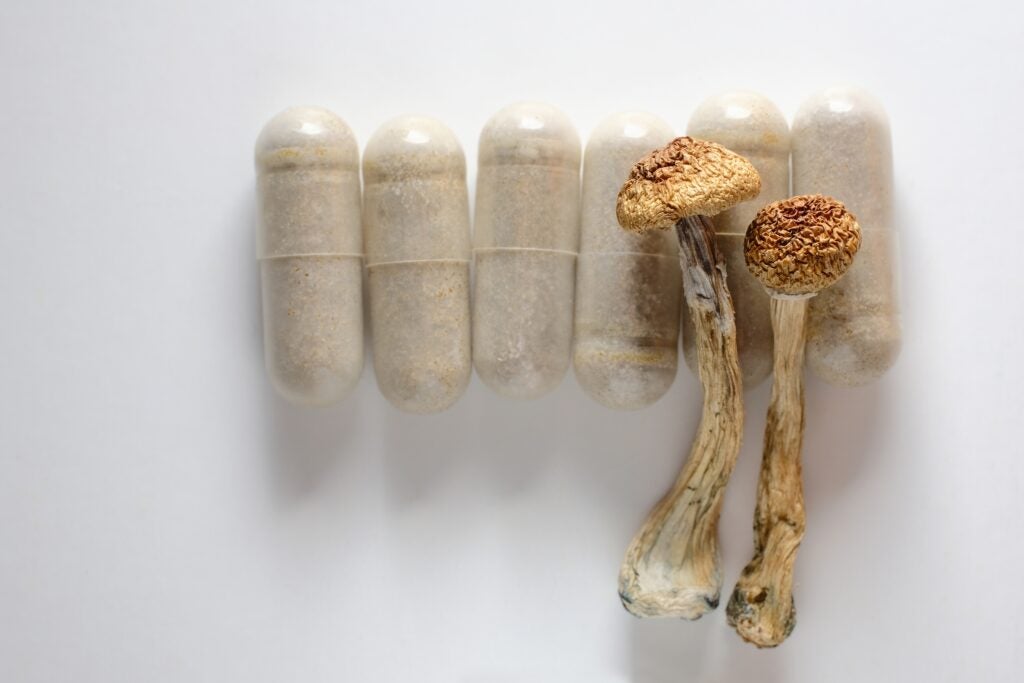Standardized psilocybin supply matters in Massachusetts because trials rise or fall on product consistency, documentation, and on time delivery. Hospitals in Boston and Worcester can run session based studies only when pharmacy teams receive uniform lots with clear labels, matched placebo, and records that satisfy FDA, DEA, and IRB reviews. A steady supply chain protects visit windows, holds the blind, and keeps audit files intact.
Why standardized supply matters in clinical settings
Clinical settings depend on repeatable inputs. Psilocybin trials schedule long sessions with safety monitoring and follow up visits over months. Any variability in dose strength, impurity profile, or packaging can trigger deviations that disrupt calendars. Standardization narrows these risks.
Uniform dose forms support accurate counts and clean blinding. Capsules and sublingual tablets in fixed strengths allow pharmacies to issue kits without manipulation. Matched placebo prevents visual or weight clues. Labels that follow a single template reduce handling mistakes across shifts.
Validated testing underpins confidence. Lots should ship with a certificate of analysis that lists method IDs, assay values for psilocybin and psilocin, impurities, microbiology, and analyst signoff. Acceptance ranges tell pharmacies what to expect. Stability summaries explain storage conditions, expiry dates, and in use limits. When these files align with site SOPs, intake moves quickly and audits move faster.
Chain of custody completes the picture. Shipment memos must mirror permits and kit lists. Temperature data from shippers and storage confirms that lots stayed inside limits. Receipt logs tie kit IDs to cartons, then to locked storage. These links let monitors trace each dose back to a tested lot without gaps.
Pharmacy and site setup steps in MA
Massachusetts hospitals already manage complex studies. Psilocybin work adds controlled handling and session day flow. A stepwise setup keeps teams aligned.
Governance and approvals
Confirm IRB approval before booking shipments. Pharmacy and therapeutics reviews dose form, blinding plan, storage, and reconciliation. Risk management aligns incident reporting. Security reviews access control for storage rooms and routes from dock to pharmacy.
Storage and access
Schedule I materials remain in locked rooms or safes with restricted access. Access lists match training records. Daily checks confirm locks and temperatures. Keys or codes are issued only to staff on the access list. Contact details for the custodian and backups are posted for dock and security teams.
Intake rehearsal
Run a mock receipt with a pilot kit. Practice seal checks, label verification, kit logging, and temperature data download. This short exercise catches barcode mismatches, carton map confusion, or missing forms before the main lot arrives.
Receiving and logging
On delivery day the consignee verifies names, addresses, and permit details on airway bills. Staff inspect seals, reconcile counts, and log kit IDs. Temperature files from the shipper are downloaded and saved. Any variance is recorded with an immediate action and a short plan to prevent repeats.
Preparation and dispensing
Pharmacies issue kits per the randomization plan. Staff record kit ID, subject code, date, time, and initials. Unused units return to storage and counts are updated the same day. For multi site programs, depots can stage resupply while maintaining clean chain records into each hospital.
Session day coordination
Coordinators align room bookings with pharmacy issue times. Therapists and clinical staff document preparation, acute support, vitals, and recovery checks. Nearby medical teams receive the schedule in case assistance is required. After sessions, pharmacies reconcile returns and file any deviations before close of business.
Ongoing controls
Weekly accountability checks compare expected versus physical counts. Temperature logs are reviewed and filed. Deviation trends are discussed in short huddles with actions assigned. At closeout, remaining kits are returned to a depot or destroyed with witnesses under SOPs, then certificates are filed.
How DEA permits align with state requirements
Massachusetts uses federal controls for psilocybin research. State agencies do not replace DEA oversight. Instead, hospital policies and campus rules sit on top of federal law and shape daily practice.
DEA Schedule I registration
A receiving site must hold a DEA Schedule I researcher registration tied to the exact address that will store psilocybin. Large systems sometimes centralize storage in a research pharmacy that services linked clinics. The registration model must match that flow, and accountability must reflect every handoff to dispensing locations.
DEA import permits when applicable
If material will cross a border, the Massachusetts site applies for a DEA import permit. The permit lists the substance, quantity, supplier, and route. Dates must match realistic shipping windows. Shipment memos mirror permit fields to speed customs review. Accurate consignee names and a reachable pharmacy contact shorten questions at clearance.
State level coordination
Massachusetts law does not add a separate psilocybin license for research. Hospitals still follow state pharmacy rules, controlled substance storage standards, and campus security policies. Those rules require clear access lists, shift coverage, and incident reporting that track with staff roles. Aligning federal permits with these local policies keeps inspections straightforward.
Documentation fit
Federal and state expectations converge on records. Site files should include IRB approval, DEA registration, import permits if used, COAs, release letters, stability summaries, shipment memos, receipt logs, temperature files, accountability, deviations, and destruction certificates. Massachusetts academic hospitals are used to this structure from other controlled substance work, which lowers friction for psilocybin trials.
Operational links
Permits and policies do not move product on their own. Brokers need exact consignee names and phone numbers. Docks need delivery windows and badge access. Pharmacies need kit maps and label sets that match randomization. When these basics line up with the permit, intake runs on time and storage records remain clean.
Timeline from inquiry to delivery in MA institutions
A predictable timeline helps sponsors, CROs, and hospitals avoid overruns. The outline below reflects common steps in Boston and Worcester.
Week 0 to 2 inquiry and scoping
Sponsors share protocol objectives, dose form, strengths, visit schedules, and first patient dates. Hospitals confirm internal reviews and pharmacy capacity. Suppliers respond with product options, stability windows, and a draft kit map. All parties agree on a single consignee with trained backups.
Week 2 to 6 documentation assembly
Suppliers provide COA templates, release letter formats, and stability summaries for IRB and pharmacy review. Hospitals finalize receipt and reconciliation SOPs that reference psilocybin by name. Randomization teams align label sets with coding rules. If importing, sites gather details needed for the DEA permit request.
Week 4 to 8 permits and registrations
Sites confirm DEA Schedule I registrations are active for the receiving address. If an import is planned, the site submits a permit request that lists the exact substance names, quantities, supplier, route, and a practical arrival window. Sponsors, suppliers, and brokers share contacts for customs and the receiving dock.
Week 6 to 9 intake rehearsal
Pharmacies receive pilot kits for mock intake. Teams practice barcode scans, label checks, kit logging, and temperature file downloads. Any mismatch in labels, carton maps, or forms is corrected before production lot shipment.
Week 8 to 10 manufacturing and release
Suppliers complete batch production, run validated methods for identity, assay, impurities, and microbiology, then issue a release letter. Placebo kits are packed to match weight and appearance. Expiry dates are checked against visit windows to avoid mid study shortages.
Week 9 to 11 routing and booking
Controlled couriers are booked with temperature shippers and data loggers. Shipment memos mirror permit details. Brokers receive consignee contacts and delivery windows. Receiving docks place the shipment on the schedule and confirm badge access for drivers.
Week 10 to 12 delivery and intake
Shipments arrive within the permit window. Pharmacies inspect seals, verify labels, reconcile counts, and download temperature files. Kits move to locked storage. Intake logs, temperature files, and chain records are filed the same day. If any variance occurs, deviations are recorded with immediate steps and a plan to prevent repeats.
Week 12 and beyond dosing and resupply
Session days proceed with pharmacy issue aligned to room schedules. Sponsors monitor inventory and expiries across sites. Depots or direct shipments cover resupply. Weekly accountability checks and temperature reviews continue through closeout. At the end of the study, remaining kits are returned or destroyed with certificates filed.
This cadence can shift with IRB calendars, permit queues, or weather. The key is parallel work. Hospitals, sponsors, and suppliers keep documents, permits, and intake rehearsal moving at the same time to hold the first session date.
Why supply readiness matters for trial success
Supply readiness turns a good protocol into real dosing days. In Massachusetts, where hospitals handle many complex trials, teams succeed when product, paperwork, and people are synchronized.
Product readiness
Uniform dose forms, matched placebo, validated methods, and clear stability windows reduce pharmacy burden. Labels that match the randomization plan and kit maps that match pharmacy workflows prevent handling errors. Clean batch records and release letters shorten questions during audits.
Paperwork readiness
COAs, release letters, stability summaries, shipment memos, IRB approvals, DEA registrations, and permits should be present and easy to find. Chain of custody and temperature files should link shipment to storage to dispense. Binder maps or indexed folders let monitors trace each kit from release to destruction without scavenger hunts.
People readiness
Two trained staff per role protects schedules. Intake rehearsals with pilot kits expose problems before the main lot arrives. Short job aids near workstations help new staff follow SOPs without mistakes. Coordinators who align room bookings with pharmacy issue times keep sessions on time.
Logistics readiness
Shipment memos that mirror permits and accurate consignee details shorten customs calls. Couriers with live contacts at docks and pharmacies prevent missed windows. Temperature shippers with clear logger instructions reduce intake delays. A reachable pharmacy custodian closes most questions in minutes.
Partner readiness
Suppliers who attend intake calls and support deviation responses save time. CROs who track expiries and trigger resupply avoid mid study shortages. Hospitals that publish checklists and binder templates help new sites ramp faster. As suppliers, we provide permit ready product data, matched placebo, kit maps, and shipment records, then join intake rehearsals so pharmacy steps match documents and labels.
Trials in Boston and Worcester can move on schedule when supply is standardized and records are steady. That is why supply readiness sits next to protocol design in importance. A clean lot with clear files, a controlled delivery with correct consignee details, and a pharmacy intake that logs kits without error are not side tasks. They are the foundation that holds session days, protects the blind, and delivers data that regulators and journals will trust.




